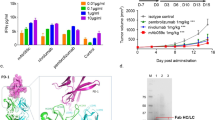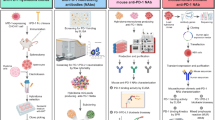Abstract
Currently, display-based methods are well established and widely used in antibody engineering for affinity maturation and structural stability improvement. We obtained a novel anti-human programmed death 1 (PD-1) antibody using computer-aided design and a mammalian cell display technology platform. We used computer-aided modeling and distance geometry methods to predict and assign the key residues that contributed to the binding of human PD-L1 to PD-1. Then, we analyzed the sequence of nivolumab (an anti-human PD-1 antibody, referred to as MIL75 in the article) to determine the template for antibody design and library construction. We identified a series of potential substitutions on the obtained template and constructed a virtual epitope-targeted antibody library based on the physicochemical properties and each possible location of the assigned key residues. The virtual antibody libraries were displayed on the surface of mammalian cells as the antigen-binding fragments of full-length immunoglobulin G. Then, we used flow cytometry and sequencing approaches to sort and screen the candidates. Finally, we obtained a novel anti-human PD-1 antibody named FV78. FV78 competitively recognized the PD-1 epitopes that interacted with MIL75 and possessed an affinity comparable to MIL75. Our results implied that FV78 possessed equivalent bioactivity in vitro and in vivo compared with MIL75, which highlighted the probability and prospect of FV78 becoming a new potential antibody therapy.
This is a preview of subscription content, access via your institution
Access options
Subscribe to this journal
Receive 12 digital issues and online access to articles
$119.00 per year
only $9.92 per issue
Buy this article
- Purchase on Springer Link
- Instant access to full article PDF
Prices may be subject to local taxes which are calculated during checkout





Similar content being viewed by others
References
Carter PJ . Potent antibody therapeutics by design. Nat Rev Immunol 2006; 6: 343–357.
Presta LG . Molecular engineering and design of therapeutic antibodies. Curr Opin Immunol 2008; 20: 460–470.
Forsyth CM, Juan V, Akamatsu Y, DuBridge RB, Doan M, Ivanov AV et al. Deep mutational scanning of an antibody against epidermal growth factor receptor using mammalian cell display and massively parallel pyrosequencing. mAbs 2013; 5: 523–532.
Amit AG, Mariuzza RA, Phillips SE, Poljak RJ . Three-dimensional structure of an antigen-antibody complex at 2.8A resolution. Science 1986; 233: 747–753.
Jones PT, Dear PH, Foote J, Neuberger MS, Winter G . Replacing the complementarity-determining regions in a human antibody with those from a mouse. Nature 1986; 321: 522–525.
Berek C, Griffiths GM, Milstein C . Molecular events during maturation of the immune response to oxazolone. Nature 1985; 316: 412–418.
Lea S, Stuart D . Analysis of antigenic surfaces of proteins. FASEB J 1995; 9: 87–93.
Padlan EA . On the nature of antibody combining sites: unusual structural features that may confer on these sites an enhanced capacity for binding ligands. Proteins 1990; 7: 112–124.
Zemlin M, Klinger M, Link J, Zemlin C, Bauer K, Engler JA et al. Expressed murine and human CDR-H3 intervals of equal length exhibit distinct repertoires that differ in their amino acid composition and predicted range of structures. J Mol Biol 2003; 334: 733–749.
Davies DR, Cohen GH . Interactions of protein antigens with antibodies. Proc Natl Acad Sci USA 1996; 93: 7–12.
Padlan EA . Anatomy of the antibody molecule. Mol Immunol 1994; 31: 169–217.
Rao BM, Lauffenburger DA, Wittrup KD . Integrating cell-level kinetic modeling into the design of engineered protein therapeutics. Nat Biotechnol 2005; 23: 191–194.
De Genst E, Areskoug D, Decanniere K, Muyldermans S, Andersson K . Kinetic and affinity predictions of a protein-protein interaction using multivariate experimental design. J Biol Chem 2002; 277: 29897–29907.
Zhang W, Feng J, Li Y, Guo N, Shen B . Humanization of an anti-human TNF-α antibody by variable region resurfacing with the aid of molecular modeling. Mol Immunol 2005; 42: 1445–1451.
Qin W, Feng J, Zhang W, Li Y, Shen B . A novel TNFalpha antagonizing peptide-Fc fusion protein designed based on CDRs of TNFalpha neutralizing monoclonal antibody. Biochem Biophys Res Commun 2004; 322: 1024–1028.
Chang H, Qin W, Li Y, Zhang J, Lin Z, Lv M et al. A novel human scFv fragment against TNF-alpha from de novo design method. Mol Immunol 2007; 44: 3789–3796.
Qiao C, Lv M, Li X, Geng J, Li Y, Zhang J et al. Affinity maturation of antiHER2 monoclonal antibody MIL5 using an epitope-specific synthetic phage library by computational design. J Biomol Struct Dyn 2013; 31: 511–521.
Yang J, Wang Q, Qiao C, Lin Z, Li X, Huang Y et al. Potent anti-angiogenesis and anti-tumor activity of a novel human anti-VEGF antibody, MIL60. Cell Mol Immunol 2014; 11: 285–293.
Hoogenboom HR . Selecting and screening recombinant antibody libraries. Nat Biotechnol 2005; 23: 1105–1116.
Zhou C, Jacobsen FW, Cai L, Chen Q, Shen WD . Development of a novel mammalian cell surface antibody display platform. mAbs 2010; 2: 508–518.
Okazaki T, Honjo T . The PD-1-PD-L pathway in immunological tolerance. Trends Immunol 2006; 27: 195–201.
Dong H, Strome SE, Salomao DR, Tamura H, Hirano F, Flies DB et al. Tumor-associated B7-H1 promotes T-cell apoptosis: a potential mechanism of immune evasion. Nat Med 2002; 8: 793–800.
Iwai Y, Ishida M, Tanaka Y, Okazaki T, Honjo T, Minato N . Involvement of PD-L1 on tumor cells in the escape from host immune system and tumor immunotherapy by PD-L1 blockade. Proc Natl Acad Sci USA 2002; 99: 12293–12297.
Zou W, Chen L . Inhibitory B7-family molecules in the tumour microenvironment. Nat Rev Immunol 2008; 8: 467–477.
Topalian SL, Hodi FS, Brahmer JR, Gettinger SN, Smith DC, McDermott DF et al. Safety, activity, and immune correlates of anti-PD-1 antibody in cancer. N Engl J Med 2012; 366: 2443–2454.
Villasboas JC, Ansell SM . Nivolumab for the treatment of classical Hodgkin lymphoma after failure of autologous stem cell transplant and brentuximab. Expert Rev Anticancer Ther 2016; 16: 5–12.
Ehrenmann F, Kaas Q, Lefranc M-P . IMGT/3Dstructure-DB and IMGT/DomainGapAlign: a database and a tool for immunoglobulins or antibodies, T cell receptors, MHC, IgSF and MhcSF. Nucleic Acids Res 2010; 38: D301–D307.
Ehrenmann F, Lefranc M-P . IMGT/DomainGapAlign: IMGT standardized analysis of amino acid sequences of variable, constant, and groove domains (IG, TR, MH, IgSF, MhSF). Cold Spring Harb Protoc 2011; 2011: 737–749.
Gronwald RG, Grant FJ, Haldeman BA, Hart CE, O’Hara PJ, Hagen FS et al. Cloning and expression of a cDNA coding for the human platelet-derived growth factor receptor: evidence for more than one receptor class. Proc Natl Acad Sci USA 1988; 85: 3435–3439.
Zak KM, Kitel R, Przetocka S, Golik P, Guzik K, Musielak B et al. Structure of the complex of human programmed death 1, PD-1, and Its ligand PD-L1. Struct Lond Engl 1993 2015; 23: 2341–2348.
Kirkham PM, Neri D, Winter G . Towards the design of an antibody that recognises a given protein epitope. J Mol Biol 1999; 285: 909–915.
Acknowledgements
The work was supported by the National Natural Sciences Foundation of China grant (No. 81272528 and No.31370938), National High Technology Research and Development Program (863 Program, No. 2012AA02A302), National Science and Technology Major Projects for 'Major New Drugs Innovation and Development' (2014ZX09304311-001-002-004) and the Beijing Natural Science Foundation (No. 5152022).
Author information
Authors and Affiliations
Corresponding authors
Ethics declarations
Competing interests
The authors declare no conflict of interest.
Additional information
Supplementary Information for this article can be found on the Cellular & Molecular Immunology website
Supplementary information
Rights and permissions
About this article
Cite this article
Luo, L., Wang, S., Lang, X. et al. Selection and characterization of the novel anti-human PD-1 FV78 antibody from a targeted epitope mammalian cell-displayed antibody library. Cell Mol Immunol 15, 146–157 (2018). https://doi.org/10.1038/cmi.2016.38
Received:
Revised:
Accepted:
Published:
Issue Date:
DOI: https://doi.org/10.1038/cmi.2016.38
Keywords
This article is cited by
-
Structure-guided affinity maturation of a novel human antibody targeting the SARS-CoV-2 nucleocapsid protein
Scientific Reports (2022)
-
Novel anti-CD38 humanized mAb SG003 possessed enhanced cytotoxicity in lymphoma than Daratumumab via antibody-dependent cell-mediated cytotoxicity
BMC Biotechnology (2019)
-
Distinct contribution of PD-L1 suppression by spatial expression of PD-L1 on tumor and non-tumor cells
Cellular & Molecular Immunology (2019)
-
A novel oncolytic virus engineered with PD-L1 scFv effectively inhibits tumor growth in a mouse model
Cellular & Molecular Immunology (2019)



